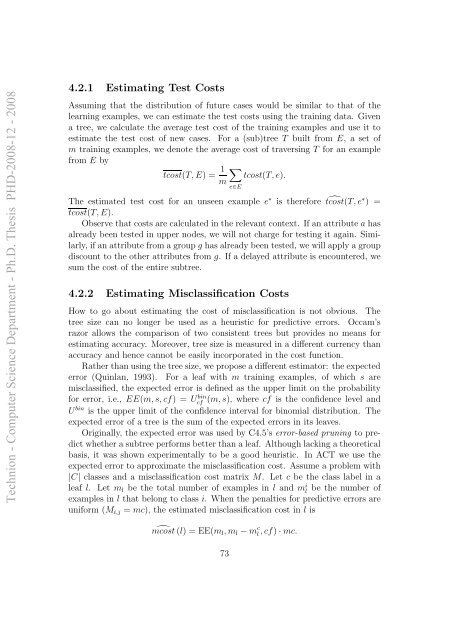anytime algorithms for learning anytime classifiers saher ... - Technion
anytime algorithms for learning anytime classifiers saher ... - Technion
anytime algorithms for learning anytime classifiers saher ... - Technion
Create successful ePaper yourself
Turn your PDF publications into a flip-book with our unique Google optimized e-Paper software.
<strong>Technion</strong> - Computer Science Department - Ph.D. Thesis PHD-2008-12 - 2008<br />
4.2.1 Estimating Test Costs<br />
Assuming that the distribution of future cases would be similar to that of the<br />
<strong>learning</strong> examples, we can estimate the test costs using the training data. Given<br />
a tree, we calculate the average test cost of the training examples and use it to<br />
estimate the test cost of new cases. For a (sub)tree T built from E, a set of<br />
m training examples, we denote the average cost of traversing T <strong>for</strong> an example<br />
from E by<br />
tcost(T, E) = 1<br />
m<br />
�<br />
tcost(T, e).<br />
The estimated test cost <strong>for</strong> an unseen example e ∗ is there<strong>for</strong>e �<br />
tcost(T, e ∗ ) =<br />
tcost(T, E).<br />
Observe that costs are calculated in the relevant context. If an attribute a has<br />
already been tested in upper nodes, we will not charge <strong>for</strong> testing it again. Similarly,<br />
if an attribute from a group g has already been tested, we will apply a group<br />
discount to the other attributes from g. If a delayed attribute is encountered, we<br />
sum the cost of the entire subtree.<br />
e∈E<br />
4.2.2 Estimating Misclassification Costs<br />
How to go about estimating the cost of misclassification is not obvious. The<br />
tree size can no longer be used as a heuristic <strong>for</strong> predictive errors. Occam’s<br />
razor allows the comparison of two consistent trees but provides no means <strong>for</strong><br />
estimating accuracy. Moreover, tree size is measured in a different currency than<br />
accuracy and hence cannot be easily incorporated in the cost function.<br />
Rather than using the tree size, we propose a different estimator: the expected<br />
error (Quinlan, 1993). For a leaf with m training examples, of which s are<br />
misclassified, the expected error is defined as the upper limit on the probability<br />
<strong>for</strong> error, i.e., EE(m, s, cf) = Ubin cf (m, s), where cf is the confidence level and<br />
Ubin is the upper limit of the confidence interval <strong>for</strong> binomial distribution. The<br />
expected error of a tree is the sum of the expected errors in its leaves.<br />
Originally, the expected error was used by C4.5’s error-based pruning to predict<br />
whether a subtree per<strong>for</strong>ms better than a leaf. Although lacking a theoretical<br />
basis, it was shown experimentally to be a good heuristic. In ACT we use the<br />
expected error to approximate the misclassification cost. Assume a problem with<br />
|C| classes and a misclassification cost matrix M. Let c be the class label in a<br />
leaf l. Let ml be the total number of examples in l and mi l be the number of<br />
examples in l that belong to class i. When the penalties <strong>for</strong> predictive errors are<br />
uni<strong>for</strong>m (Mi,j = mc), the estimated misclassification cost in l is<br />
mcost � (l) = EE(ml, ml − m c l , cf) · mc.<br />
73











